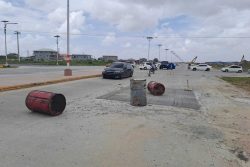Minister of Culture, Youth and Sport, Charles Ramson Jr, yesterday said that steps are being taken to fireproof Castellani House where the National Art Collection is located.
Speaking at a press conference, the Minister highlighted ongoing efforts, noting the unique challenges posed by the wooden structure.
“To fireproof Castellani House, what you need is early detection. That’s what’s important – to prevent fires from happening in the first place,” Ramson said. He mentioned that steps such as installing fire alarm systems and sprinklers have already begun in some facilities and that these efforts will continue.
The discussion comes at a critical time, as Castellani House is not only a heritage building, but also the home of Guyana’s National Art Collection. Designed by Maltese architect, Cesar Castellani, in 1879, the structure is the last surviving Castellani masterpiece, following the demolition of the Alms House and the New Amsterdam Public Hospital. Originally completed in 1882 to house George Jenman, the first Curator of the Botanical Gardens, Castellani House later served as the residence of colonial Directors of Agriculture, Prime Minister Forbes Burnham, and eventually became a hub for the arts.
In 1993, following renovations by the PPP/C government, Castellani House was designated as the home of the National Art Collection. For decades, it has served as a vital centre for visual arts, showcasing works by Guyana’s most renowned artists. However, the building’s limitations – being a wooden structure with limited space – have long raised concerns.
Artist Stanley Greaves has been an outspoken advocate for relocating the collection to a purpose-built, fire-resistant facility. Greaves highlighted that Guyana’s art collection is the largest of its kind in the Caribbean not housed in a concrete building, unlike those in Jamaica, Cuba, and Martinique. He stressed the importance of proper storage and display, noting, “The care provided reflects governmental concern about the cultural value and importance of such collections to their developing history.”
The Minister confirmed that plans are underway for a new museum and art gallery, with design submissions already received. However, the location for this new facility is still to be decided.
Cultural advocates, including Greaves, have proposed accessible sites such as D’Urban Park, emphasising the need for an artistically inspired design rather than utilitarian structures.
The new facility is envisioned to include temperature-controlled storage, a conservation workshop, a lecture theatre, and a comprehensive online inventory of the collection. Additionally, there are calls for advanced training for curators and the revival of an advisory committee of art-oriented volunteers, which could help shape future exhibitions and programmes.
The National Art Collection, established in 1950, is a cornerstone of Guyanese heritage, featuring hundreds of paintings, sculptures, and ceramics. It includes works by luminaries such as Philip Moore, Aubrey Williams, E.R. Burrowes, and Bernadette Persaud.
Ramson stressed the government’s commitment to investing in the arts, stating, “We’re in a better position now, making a lot more investments, and we’ve started to understand the importance of standards.”










